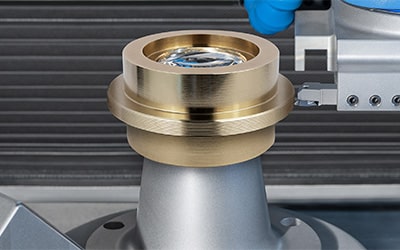TRIOPTICS’ ATS alignment turning stations now enable cutting of threads and grooves
centered on the optical axis during the edge processing of mounted lenses
For high-precision lenses, the method of mounting single lenses in sub-cells and processing them using alignment turning has proven effective. During this process, the edge of the mount and the flange surfaces of mounted lenses are produced in a way so that the axis of symmetry of the mount coincides with the optical axis of the lens and ensuring that all lenses have the correct air gaps between them. After being machined, the mounted lenses are inserted into a lens barrel – without requiring any additional alignment steps. In many cases, clamping rings are used at both ends of the barrel to secure the elements within the lens barrel. If the inside of the lens needs to be sealed, for example because it is filled with gas, additional O-rings are used.
The TRIOPTICS ATS 100, 200, 200 UP, and 300 UP alignment turning stations now enable advanced processing of the lens edge with threads and grooves. The thread or groove is cut directly on the lens mount, thus saving time by integrating this into a single work process along with the other steps of the mount edge machining. The scope of functions on these alignment turning machines can be expanded at any time: the upgrade includes a software enhancement and the required tools.
In addition to saving time, the combination of thread or groove cutting with an alignment turning machine offers further advantages due to the alignment of the chuck with the optical axis of the lens. The threads and grooves are centered to the optical axis of the lens, while the standardized flank angles of the threads and grooves are achieved in a uniformly and reproducible way as a result of the simple tool movement in only one direction.
Applying a thread to the lens mount enables a fixed positioning of this element itself, which eliminates the need for clamping rings or allows individual, critical elements to be easily fixed within the assembly. This offers particular benefits if the overall size of the lens has to be reduced. Grooves allow secure positioning of the O-rings and thus ensure optimal sealing of the lens against leakage of the filling gas.



